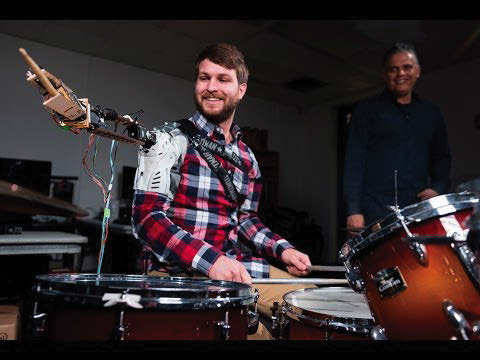WASHINGTON (TIP): Scientists have developed a ‘smart’ wearable robotic limb that responds to human gestures and the music it hears, allowing drummers to play with three arms.
The two-foot long robotic arm can be attached to a musician’s shoulder, and knows what to play by listening to the music in the room. It improvises based on the beat and rhythm.
For instance, if the musician plays slowly, the arm slows the tempo. If the drummer speeds up, it plays faster.
Another aspect of its intelligence is knowing where it is located at all times, where the drums are, and the direction and proximity of the human arms.
“When the drummer moves to play the high hat cymbal, for example, the robotic arm manoeuvres to play the ride cymbal. As the drummer switches to the snare, the mechanical arm shifts to the tom,” said researchers from the Georgia Institute of Technology in US.
When the robot approaches an instrument, it uses built-in accelerometers to sense the distance and proximity. On-board motors make sure the stick is always parallel to the playing surface, allowing it to rise, lower or twist to ensure solid contact with the drum or cymbal.
“The third arm provides a much richer and more creative experience, allowing the human to play many drums simultaneously with virtuosity and sophistication that are not otherwise possible,” said Gil Weinberg, director of the Centre for Music Technology at Georgia.
The arm moves naturally with intuitive gestures because it was programmed using human motion capture technology.
Researchers built the arm after creating a robotic prosthesis for an Atlanta drummer. That device had two sticks, one with a mind of its own.
The prosthetic arm allowed the man to continue his musical passion after losing an arm in an accident, while also making him the fastest drummer in the world.
Its success led Weinberg to create the “third arm” robot, something that anyone can wear and become a cyborg drummer. “If you have a robotic device that is part of your body, it’s a completely different feeling from working alongside a regular robot,” said Weinberg.
“The machine learns how your body moves and can augment and complement your activity,” he said.
There could be other applications for the technology, researchers said.
“Imagine if doctors could use a third arm to bring them tools, supplies or even participate in surgeries. Technicians could use an extra hand to help with repairs and experiments,” Weinberg added.
